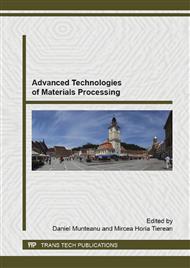[1]
G. E. Spriggs, History of Fine Grained Hardmetal, Int. J. of Refactory Metals & Hard Materials 13 (1995) 241-255.
DOI: 10.1016/0263-4368(95)92671-6
Google Scholar
[2]
B. Zeiler, The potential of conventional tungsten carbide powder manufacturing, Plansee Proceedings 4 (1997) 265-276.
Google Scholar
[3]
Y. Yamamoto, A. Matsumoto, Y. Doi, Properties of ultrafine tungsten carbide and cemented carbides by direct carburization, Plansee Proceedings 2 (1997) 596-608.
Google Scholar
[4]
R. Koc, S. K. Kodambaka, Tungsten carbide (WC) synthesis from novel precursors, J. of the European Ceramic Society 20 (2000) 1859-1869.
DOI: 10.1016/s0955-2219(00)00038-8
Google Scholar
[5]
K. M Andersson, Aqueous Processing of WC-Co Powders, Royal Institute of Technology Doctoral Thesis Stockholm (2004).
Google Scholar
[6]
Z.Y. Zhang, S. Wahlberg, M.S. Wang, M. Muhammed, Processing of nanostructured WC–Co powder from precursor obtained by coprecipitation. Nanostruct Mater 12 (1999) 163-166.
DOI: 10.1016/s0965-9773(99)00089-6
Google Scholar
[7]
G. Lee, G.H. Ha, B.K. Kim, Synthesis of nanostructure W base composite powders by chemical processes. J Korean Inst Metal Mater 37 (1999) 1233-1237.
Google Scholar
[8]
P. Seegopaul, L.E. McCandlish, F.M. Shinneman, Production capability and powder processing methods for nanostructured WC-Co powder, Int. J. of Refractory Metals and Hard Materials 15 (1997) 133-138.
DOI: 10.1016/s0263-4368(96)00044-3
Google Scholar
[9]
ASM Handbook, Powder Metallurgy 8th edition, Ohio, (1991).
Google Scholar
[10]
C. Suryanarayana, Mechanical alloying and milling, Progress in Materials Science 46 (2001) 1-184.
Google Scholar
[11]
S. Mi, T. H Courtney, Synthesis of WC and WC-Co cermets by mechanical alloying and subsequent hot isostatic pressing, Scripta Materialia 38 (1997) 171-176.
DOI: 10.1016/s1359-6462(97)00410-7
Google Scholar
[12]
M.S. El-Eskandarany, A. Mahday, H. A Ahmed, Synthesis and characterizations of ball-milled nanocrystalline WC and nanocomposite WC–Co powders and subsequent consolidations, Amer. J. of Alloys and Compounds 312 (2000) 315-325.
DOI: 10.1016/s0925-8388(00)01155-5
Google Scholar
[13]
S. Liu, L. Huang, G. Liu, G.B. Yang, Preparing nano-crystalline rare earth doped WC/Co powder by high energy ball milling, Int. J. of Refractory Metals and Hard Materials 24 (2006) 461-464.
DOI: 10.1016/j.ijrmhm.2005.10.001
Google Scholar
[14]
S. Bolokang, C. Banganayi, M. Phasha, Effect of C and milling parameters on the synthesis of WC powders by mechanical alloying, Int. J. of Refractory Metals and Hard Materials 28 (2010) 211-216.
DOI: 10.1016/j.ijrmhm.2009.09.006
Google Scholar
[15]
M.H. Enayati, G.R. Aryanpour, A. Ebnonnasir, Production of nanostructured WC–Co powder by ball milling, Int. J. of Refractory Metals and Hard Materials 27 (2009) 159-163.
DOI: 10.1016/j.ijrmhm.2008.06.005
Google Scholar
[16]
F.L. Zang, M. Zhu, C.Y. Wang, Parameters optimization in the planetary ball milling of nanostructured tungsten carbide/cobalt powder, International Journal of Refractory Metals and Hard Materials 26 (2008) 329-333.
DOI: 10.1016/j.ijrmhm.2007.08.005
Google Scholar
[17]
Q. Yuan, Y. Zheng, H. Yu, Synthesis of nanocrystalline Ti(C, N) powders by mechanical alloying and influence of alloying elements on the reaction, Int. J. of Refractory Metals and Hard Materials 27 (2009) 121-125.
DOI: 10.1016/j.ijrmhm.2008.05.002
Google Scholar
[18]
R. Mansour, M. R. Rahimipour, R. Yazdani-Rad, A novel technique for production of nano-crystalline mono tungsten carbide single phase via mechanical alloying, J. of Alloys and Compounds 509 (2011) 6683-6688.
DOI: 10.1016/j.jallcom.2011.03.137
Google Scholar
[19]
J. Ma, S.G. Zhu, Direct solid-state synthesis of tungsten carbide nanoparticles from mechanically activated tungsten oxide and graphite. Int. Journal of Refractory Metals and Hard Materials 28 (2010) 623–627.
DOI: 10.1016/j.ijrmhm.2010.06.004
Google Scholar


